Review: Omar Sharif Bridge
Score:
80%
Version Reviewed: 2.00(03)F
Buy Link | Download / Information Link
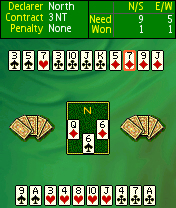 There’s a certain mystique built up around the game of Bridge – it’s regarded as complicated, hard to understand, and something played by "English Gentlemen over an exquisite plate of Lemon Sole at Blades (The Gentlemen’s Club in Mayfair)” Nothing could be further from the truth, and with ZingMagic’s Omar Sharif Bridge for S60 you can join in.
There’s a certain mystique built up around the game of Bridge – it’s regarded as complicated, hard to understand, and something played by "English Gentlemen over an exquisite plate of Lemon Sole at Blades (The Gentlemen’s Club in Mayfair)” Nothing could be further from the truth, and with ZingMagic’s Omar Sharif Bridge for S60 you can join in.
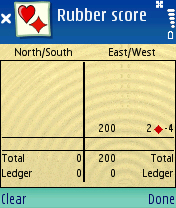 Okay, a quick touching base on how to play Bridge. There are three main parts – and like a Quentin Tarantino movie I’ll start with the middle portion. It’s simply Trumps. Each player (there are four) plays one card, and the highest value wins that round – if there is a trump suit then that card will win, unless a card in the trump suit with a higher value is played. All the cards are dealt, so it’s the best of 13 rounds.
Okay, a quick touching base on how to play Bridge. There are three main parts – and like a Quentin Tarantino movie I’ll start with the middle portion. It’s simply Trumps. Each player (there are four) plays one card, and the highest value wins that round – if there is a trump suit then that card will win, unless a card in the trump suit with a higher value is played. All the cards are dealt, so it’s the best of 13 rounds.
And here comes the big twist (as it were) with Bridge. You’re not playing against the other three players. You are paired up with the person sitting opposite you at the (square) table, and you are fighting the other pair. Traditionally these seats at the cable are represented by compass directions, so North and South play against East and West.
Once all 13 rounds (called tricks) are played, the winning pair get a score – you get 20 points per trick if clubs or diamonds were trumps, 30 points if it was hearts or spades, or 30 points plus a bonus ten points if there is no trump suit. You need 100 points to win a rubber (round) so you’ll be playing a few games – there are also bonus points you can score for making more tricks than you agreed to, or points if you stop the other partnership making as many tricks as they promised they would.
 Which leads back to the start – how you decide what the trump suit is and how many tricks you will win. You conduct an auction, moving round each player at the table in turn as many times as it takes to come to an agreement about which partnership will make "the contract", i.e. the number of tricks they will win with a certain suit as trumps. The catch is rather than speak English, you can only use the numbers 1-7, the suits, and the words "no-trumps, double, redouble and pass”. It’s this bidding process that gives Bridge an air of complexity, when in fact this is the most strategic part of the game.
Which leads back to the start – how you decide what the trump suit is and how many tricks you will win. You conduct an auction, moving round each player at the table in turn as many times as it takes to come to an agreement about which partnership will make "the contract", i.e. the number of tricks they will win with a certain suit as trumps. The catch is rather than speak English, you can only use the numbers 1-7, the suits, and the words "no-trumps, double, redouble and pass”. It’s this bidding process that gives Bridge an air of complexity, when in fact this is the most strategic part of the game.
So how does ZingMagic’s Omar Sharif Bridge cope with all these elements? Surprisingly well is the answer – assuming you know the mechanics of Bridge. There’s no easy tutorial for getting started, there is the assumption that you already know what Bridge is all about. And to be honest the amount of info that you could present on the S60 screen is not a huge amount, so this is a good call on the game – address the application directly at the niche market of existing Bridge players.
Players will be pleased to see that you can set up your major bidding conventions, such as Jacoby Transfers, Strong 2Clubs, Weak 1 No Trumps [whoa, you just lost me again - Ed], and toggle between Acol and American bidding. You’ve got a number of options to alter the layout of the cards in your hand and how they are shown on the table.
And the great thing about Bridge is that being a partners game – you are playing with the same computer AI in your partnership as the AI level in your opponents, and there is always the option for a hint at any stage of play if you are looking for the best way forward or seeing what decisions the computer would make compared to your own.
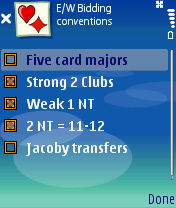
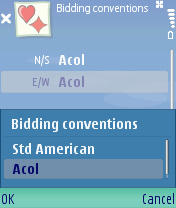
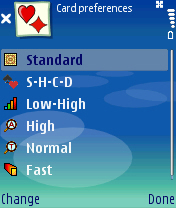
I’m not the world’s strongest Bridge player (I can play it socially and not embarrass myself, but that’s about it), but I’d say that I’m in the market that ZingMagic is addressing with this game, and I’m really enjoying the challenge that Bridge sets me on S60 3rd Edition. It’s obvious it won’t be everyone’s cup of tea, but that’s the beauty of it. There’s no concession for the absolute beginner. Omar Sharif Bridge is tightly focussed on the people who will regularly use it, it provides a challenge to them, and it’s a great mobile game that you can play for a few minutes or a 30 minute session.
Ewan Spence, 30 Jan 2007
Reviewed by Ewan Spence at
